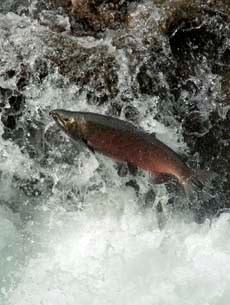|
"The restoration of depleted fish stocks and threatened or endangered species is a high priority for fishery management in the national park system." - Final Supplemental EIS on Elwha River and Ecosystem Restoration Implementation Jump to: 
Ken and Mary Campbell Overview: Removal of two dams and restoration of the Elwha River will allow the return of anadromous fish stocks that once flourished in the river. To minimize impacts to the remaining fish in the river, all steps of dam removal must be approached with caution. During the dam removal process, pulses of sediment will be released, causing short-term habitat degradation in the middle portion of the river. The temporary impact to fish will ultimately provide anadromous populations with spawning habitiat as the fine sediment previously held behind the dams redistributes down stream. View the Potential Range Map of salmonids after dam removal and ecosystem restoration. Objectives: Over the 20 to 30 years following dam removal, biologists predict that populations of anadromous stocks will rebound to historic numbers. The restoration strategies developed for each Elwha salmonid are intended to be adaptive and flexible, and may change based on how the fish populations respond. If one strategy proves to be unsuccessful, biologists will use another in order to produce a healthy, naturally spawning population. Individual Restoration Plans: Chinook Salmon Complete Restoration Plan (200-page PDF): S. Brenkman, G. Pess, C. Torgersen, K. Kloehn, J. Duda, and S. Corbett, "Predicting Recolonization Patterns and Interactions between Potamodromous and Anadromous Salmonids in Response to Dam Removal in the Elwha River, Washington, USA," Northwest Science, Vol. 82, Special Issue, 2008, pp. 91-106. Patrick Connolly and Samuel Brenkman, "Fish Assemblage, Density, and Growth in Lateral Habitats Within Natural and Regulated Sections of Washington's Elwha River Prior to Dam Removal," Northwest Science, Vol. 82, Special Issue, 2008, pp. 107-118. S. Brenkman, S. Mumford, M. House, and C. Patterson, "Establishing Baseline Information on the Geographic Distribution of Fish Pathogens Endemic in Pacific Salmonids Prior to Dam Removal and Subsequent Recolonization by Anadromous Fish in the Elwha River, Washington," Northwest Science, Vol. 82, Special Issue, 2008, pp. 142-152.
|
Last updated: May 2, 2025

